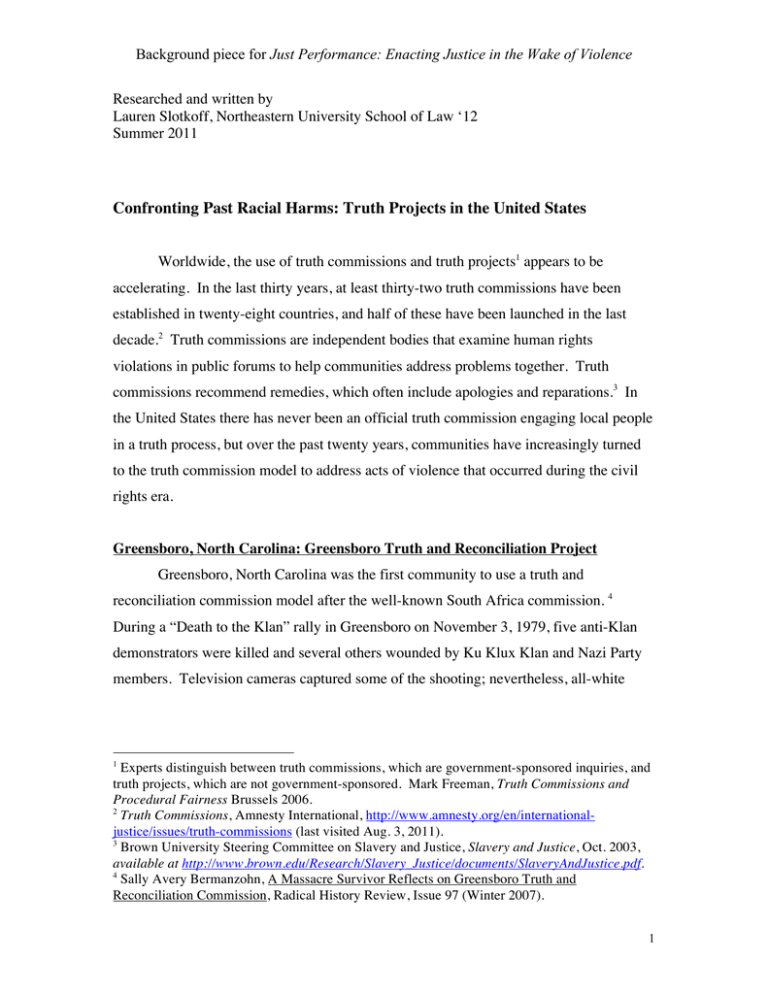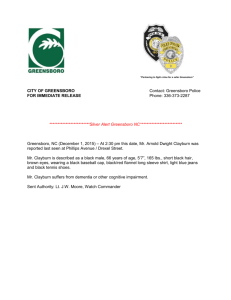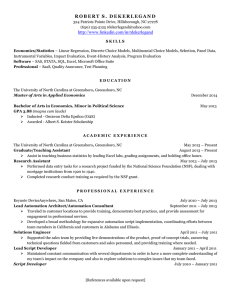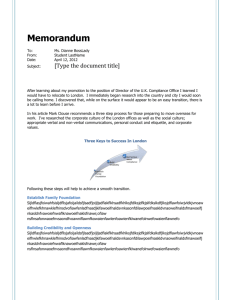Document 14539564
advertisement

Background piece for Just Performance: Enacting Justice in the Wake of Violence Researched and written by Lauren Slotkoff, Northeastern University School of Law ‘12 Summer 2011 Confronting Past Racial Harms: Truth Projects in the United States Worldwide, the use of truth commissions and truth projects1 appears to be accelerating. In the last thirty years, at least thirty-two truth commissions have been established in twenty-eight countries, and half of these have been launched in the last decade.2 Truth commissions are independent bodies that examine human rights violations in public forums to help communities address problems together. Truth commissions recommend remedies, which often include apologies and reparations.3 In the United States there has never been an official truth commission engaging local people in a truth process, but over the past twenty years, communities have increasingly turned to the truth commission model to address acts of violence that occurred during the civil rights era. Greensboro, North Carolina: Greensboro Truth and Reconciliation Project Greensboro, North Carolina was the first community to use a truth and reconciliation commission model after the well-known South Africa commission. 4 During a “Death to the Klan” rally in Greensboro on November 3, 1979, five anti-Klan demonstrators were killed and several others wounded by Ku Klux Klan and Nazi Party members. Television cameras captured some of the shooting; nevertheless, all-white 1 Experts distinguish between truth commissions, which are government-sponsored inquiries, and truth projects, which are not government-sponsored. Mark Freeman, Truth Commissions and Procedural Fairness Brussels 2006. 2 Truth Commissions, Amnesty International, http://www.amnesty.org/en/internationaljustice/issues/truth-commissions (last visited Aug. 3, 2011). 3 Brown University Steering Committee on Slavery and Justice, Slavery and Justice, Oct. 2003, available at http://www.brown.edu/Research/Slavery_Justice/documents/SlaveryAndJustice.pdf. 4 Sally Avery Bermanzohn, A Massacre Survivor Reflects on Greensboro Truth and Reconciliation Commission, Radical History Review, Issue 97 (Winter 2007). 1 Background piece for Just Performance: Enacting Justice in the Wake of Violence juries twice acquitted the white shooters of criminal charges.5 The shootings deeply divided the Greensboro community, obliterating for many trust in police protection and confidence in the justice system. The city remained racially segregated for years thereafter. On the twentieth anniversary of the shooting, in 1999, grass roots organizers came together to consider the truth commission model to assess what occurred in 1979 and ponder its lasting legacy. In 2002, the Greensboro Truth and Reconciliation Project (“GTRP”) launched its truth process. In 2004, following a review of about seventy nominees, panelists were selected for a seven member commission. The GTRP followed the truth commission model used in South Africa. Its purpose was restorative justice, and not retribution. In 2005, the GTRP held six days of hearings over the course of three months.6 Participants and attendees brought to the process a wide range of views and backgrounds. They included Ku Klux Klan leaders, survivors of the shooting, family members of victims, and Judge James Long, who presided over the criminal trial that acquitted Klan members. The hearings provided an open platform for community members to speak about the shootings and to remember how that November day affected their lives. One hundred and fifty people participated; some gave public statements and others spoke with the Commission in private. The GTRP attracted international attention. Between 2003 and 2005, a number of international leaders visited Greensboro and met with commission members, included South African Truth and Reconciliation Commissioners Archbishop Desmond Tutu and Reverend Bongani Finca, and Peru Truth Commission Member Eduardo Gonzalez. The GTRP published its findings in a 2006 report, which included recommendations that: 1. the city of Greensboro officially recognize the rally as an important point in the history of the city; 2. individuals responsible for the shootings apologize, either publicly or privately, to family members of the victims; 5 Greensboro Truth and Reconciliation Commission Report, May 25, 2006, available at http://www.greensborotrc.org/exec_summary.pdf. 6 Bermanzohn, supra note 3, at 106. 2 Background piece for Just Performance: Enacting Justice in the Wake of Violence 3. the Greensboro police department apologize for its failure to act on the day of the rally; 4. a monument be built at the site of the rally to honor the victims. 5. the city address the economic and racial injustices stemming from the rally, by requiring that schools create curriculums incorporating the events of November 3, 1979 , and requiring anti-racism training for city employees. The GTRP concluded: “we believe the truth and reconciliation process in Greensboro opened up the debate around Nov. 3, 1979 in a positive way and has successfully engaged a broad spectrum of the community in an effort that offers hope for reconciliation. As a Commission that looks a bit like Greensboro in microcosm, we found that this process — and our own struggle to hear and understand each other — had a profound impact on our perceptions of the issues we explored.”7 Detroit, Michigan: Michigan Roundtable for Diversity and Inclusion The 2000 U.S. census indicated Detroit was rapidly losing residents and was considered the most segregated of the 100 top U.S. metropolitan cities.8 Ten years later, the 2010 census indicated Detroit’s population had fallen to 713,777, the lowest since 1910.9 Detroit’s population has been simultaneously declining and dividing. Segregated housing patterns in Detroit have always been a source of conflict in the city. Historically, white neighborhood associations used exclusionary zoning laws to prevent black families from moving in. The Fair Housing Association practiced discriminatory lending and located public housing in undesirable areas.10 In its effort to assess the history and legacy of housing segregation in the city, the Michigan Roundtable for Diversity and Inclusion (“MRDI”) looked to the successful 7 Greensboro Truth and Reconciliation Commission Report, supra note 4, at 38. Michigan Roundtable for Diversity and Inclusion, Declaration of Intent Race, Residence & Regional Cooperation Truth & Reconciliation Commission, June 2010, available at http://www.miroundtable.org/Roundtabledownloads/declarationofintent.pdf. 9 Katharine Q. Seelye, Detroit Census Confirms a Desertion Like None Other, N.Y. Times, March 22, 2011, http://www.nytimes.com/2011/03/23/us/23detroit.html. 10 Michigan Roundtable for Diversity and Inclusion, supra note 7, at 1-2. 8 3 Background piece for Just Performance: Enacting Justice in the Wake of Violence South African commission and the Greensboro truth process as models. The MRDI decided to create a truth project with the goal of to “allowing the region to constructively engage the problems, division, and bitterness related to past and present patterns of segregation.”11 The MRDI is now in the early stages of development. The project is currently recruiting applicants for commissioner positions and is scheduled to hold the first truth conference in November 2011. Mississippi: Mississippi Truth Project The Mississippi Truth Project (“MTP”) was launched in 2008. It started as a grassroots effort leading to a statewide project to “create a culture of truth telling that will bring to light racially motivated crimes and injustices committed in Mississippi between 1945 and 1975.”12 13 The MTP sought to pursue local initiatives to build a state-wide project. It divided Mississippi into five regions to collect oral histories from community members from each region. “Conducting an oral history project gives community members an opportunity to be heard in their own individual interviews, but also allows their communities to work closely together and benefit from oral history interviews not only in their communities, but from communities throughout the state.”14 The MTP began collecting oral histories in January 2011. 11 Michigan Roundtable for Diversity and Inclusion, supra note 7, at 2. Mississippi Truth Project, http://www.mississippitruth.org/index.htm (last visited Aug. 3, 2011). 13 Mississippi Truth Project, http://www.mississippitruth.org/pages/regional-mtgs.htm (last visited Aug. 3, 2011). Photo indicates how Mississippi will be divided into five regions. 14 Mississippi Truth Project, supra note 13. 12 4 Background piece for Just Performance: Enacting Justice in the Wake of Violence The MTP has teamed with The Welcome Table to help create dialogues about social and racial justice within Mississippi communities. The Welcome Table spearheads retreats for community leaders to help teach them how to facilitate dialogues and build truth within their communities about past injustices.15 The MTP is not only opening the discourse in Mississippi; it is also working with the State to develop civil rights history curriculum for public schools. In 2006, Mississippi passed a bill that mandates the teaching of civil and human rights in schools. The curriculum will also include specific incidents that occurred in the various regions of the state. For example, in Tallahatchie County, students will study the 1955 murder of Emmett Till. The MTP is still in its early stages of development. Boston, Massachusetts: Boston Busing/Desegregation Project In its attempts to encourage African-American parents to become more engaged with the Boston Public School system, the Union of Minority Neighborhoods (“UMN”), a community empowerment group, encountered an impenetrable wall of anger and pain stemming from the lingering impact of the city’s school desegregation and busing history. It concluded that the community could not move forward until it came to a better collective understanding of its past. After a series of discussions across the Boston communities, the UMN launched the Boston Busing/Desegregation Project (“BBDP”). The intent of BBDP is to confront the issue of busing through a community driven truth process: “Telling, sharing, and learning from stories across differences in order to co-create the history of busing and Boston school desegregation.” The BBDP’s work is centered around three key objectives: truth telling, learning from the truth, and making change based on new knowledge and understandings of the past. It is using the collective story of Boston residents to achieve a shared vision of “where we go from here.” UMN has identified three long-term goals for the BBDP: 1. Reach an understanding of the history of school desegregation in Boston, a collective story of its impact on the current state of public school education, and a shared vision of the meaning of the past for the challenges of today we go from here; 15 The Welcome Table, http://www.welcometable.net (last visited Aug. 3, 2011). 5 Background piece for Just Performance: Enacting Justice in the Wake of Violence 2. Increase support and trust in public school education; and 3. Engage a larger and more diverse body of communities in determining Boston’s vision for public school education.16 The first phase of the project, from May 2011 to June 2012 includes building awareness about the project, understanding the history that led to the busing crisis, creating a commission that appropriately reflects the Boston community, and designing phase two of the project. Conclusion These four truth projects strive to reexamine the past in order to help communities move forward. Whether a specific incident, such as the rally in Greensboro, or thirty years of history, such as the MTP has undertaken, these projects promise to allow communities to reflect on and understand their collective histories in a new way. 16 Boston Busing/Desegregation Project, Key Finds from Data to Date, April 2011, available at http://unionofminorityneighborhoods.org/images/stories/BBTP-Key_Findings.pdf. 6



